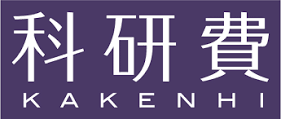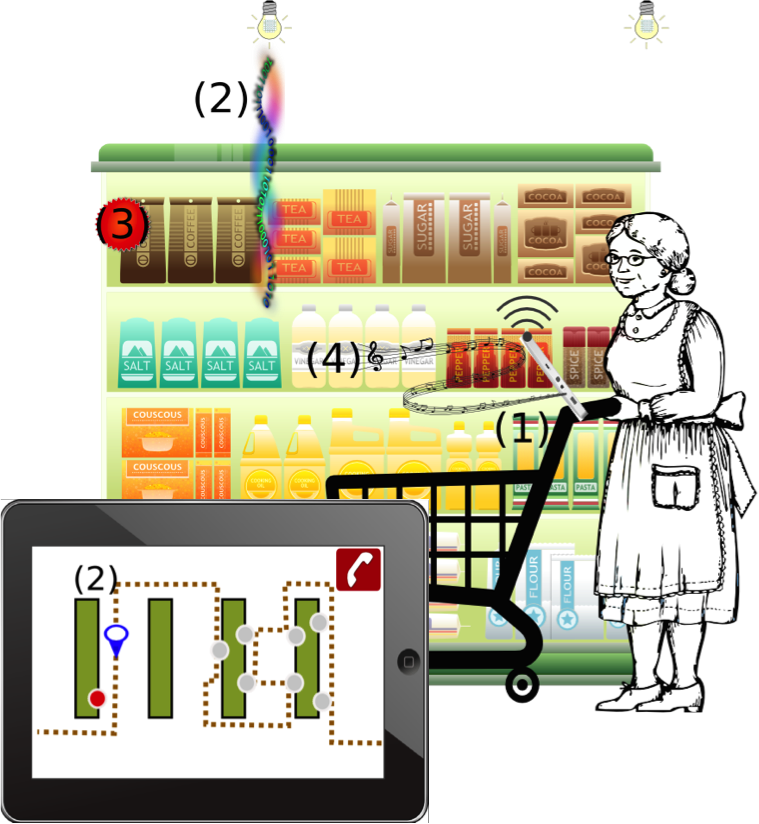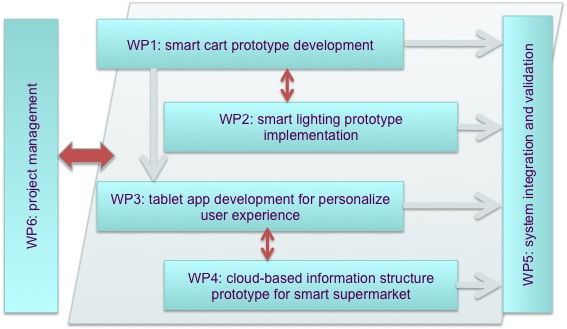| The Kakenhi
Project 15K00134 |
 |
Updates | Project Descriptions | Team | Project Management | Technologies | Publications and Reports | Sponsor
Updates
-
May 20, 2017: Second report delivered
-
May 18, 2016: First report delivered
-
May 17, 2016: Third project management meeting (report confirmation)
-
Apr. 01, 2016: Publication list updated
-
Apr. 01, 2016: Project website is uploaded
-
Sep. 28, 2015: Second project management meeting
-
April 18, 2015: First project management meeting
Project Descriptions
The future of indoor
lighting is currently moving in the direction of being
multifunctional; modern light sources have the capacity for
illumination and concurrent wireless data transmission. The merger
of these two applications has been made possible through solid-state
high brightness light emitting diode (LED) technology. LEDs have
consistently increased the light generated per package by a factor
of 20 (for a given wavelength), whereas the cost per lumen has
fallen by a factor of 10, every ten years in accordance with Haitz’s
law. Short-range optical wireless communication utilizing the
visible spectrum emitted from the LEDs, referred to as visible light
communication (VLC) transmits data via modulation of the light
intensity. So far the VLC capability is above 1 Gbit/s with a
reasonable coverage range that is applicable for home/office
environment. VLC also offers a complementary scheme to
radio-frequency (RF) communications; using a license free spectrum
and inherently secure connections (as light cannot propagate through
the surrounding walls) as well as offering immunity to all RF
interference. The dual functionality required from the LED creates
the unique opportunity for indoor localization which is much more
precise than RF counterpart. In addition the user “visually”
knows whether they will receive location data, unlike RF signal
(NFC, WIFI or RFID) might be shielded or faded.
On the other hand, smart handheld devices (e.g. tablet) usage has grown substantially in the last several years for personal and business applications. The devices are anticipated to be effortlessly used for multiple purposes and in a wide range of applications including communications, entertainment, productivity, monitoring and navigation where the last one, navigation application, is expecting to grow rapidly the next few years as human beings entering the smart society era. Therefore smart devices together with localization sensors are becoming highly integrated to form a newly supporting living-system and they will be mutually developed, well connected and affordable to every user.
This project aims to develop a prototype of a smart cart, an intelligent version of those usually found in supermarkets, a smart lighting system that support VLC-based indoor localization and data transmission, and a cloud-based infrastructure to provide a personalized customer shopping experience, as illustrated in the left figure. In particular, customers visiting a smart supermarket, like the one proposed here, could enjoy the following functions and benefits:
-
Using a network-connected smart cart in conjunction with a tablet or smartphone running an application with a friendly user interface (especially design for senior citizens), with which they could use secure, on-the-go checkout and even online billing.
-
Tablet-equipped carts enhanced with sensors developed in this project could estimate their precise location via VLC beacon signals from the available-installed supermarket’s LED-based energy-efficient lighting system.
-
Thanks to the unique location awareness function, customers could get accurate, prompt and personalized online support and recommendations, or personal assistance from supermarket staff.
-
The supermarket, based on the location of a cart and customer purchasing status, can display recommendations (including advertisements) on a tablet (visually, aurally, etc.) as the customer is moving along a given aisle.
Project Team
This project is joint research between Computer Communications Lab. (CCL) and Computer Arts lab. (CAL), the University of Aizu.
-
Principle Investigator: Professor Anh T. Pham (CCL)
-
Co-Investigators: Professor Michael Cohen (CAL), Senior Assoc. Prof. Cong-Thang Truong (CCL) and Assoc. Prof. Julian Villegas (CAL).
-
Collaborator: Dr. Hoa Le Minh (Northumbria University)
Project Management

The project implementation includes six (06) work packages (WP), as summarized in the above figure. The WP breakdown corresponds to technology and system level partitioning, and it is as the following.
-
WP1: Study and implementation of smart cart prototype with tablet and VLC receiving system, using Arduino for the interface.
-
WP2: Study and implementation of the prototype of LED-based smart lighting system (in laboratory environment) that is able to transmit ID beacon signals for localization and data transmission.
-
WP3: Design and implementation of smart apps for tablet that utilize user’s location data, purchasing status to offer personalized recommendations (e.g. goods, optimizing path) via video streaming, assistance as well as on-the-go checkout and online billing function
-
WP4: Study and development of framework of cloud-based data analysis model for supermarket’s smart sale support system.
-
WP5 is dedicated to system integration and validation.
-
WP6 is for management tasks
Technologies (under construction)
Enabling Technologies
Visible Light Communications
Ultra-Sound Communications
Indoor Positioning System
VLC Communications Networks
HTTP/2 Streaming to Mobile Terminals
Mobile App Developments
Proof-of-Concept System
Publications and Reports
AY2016
[1] Hung T. LE,
Thang VU, Nam PHAM NGOC, Anh T. PHAM, and Truong Cong THANG.
Seamless Mobile Video Streaming over HTTP/2 with Gradual Quality
Transitions. IEICE Tran. on Communications, Vol.E100-B,
No.5, pp.901-909, May 2017.
[2] Thai Hung Le, Thang Vu, Nam Pham
Ngoc, Anh T. Pham and Cong-Thang Truong. A probabilistic adaptation
method for HTTP low-delay live streaming over mobile networks. IEICE
Tran. on Information and Systems. Vol.E100-D, No.2,
pp.379--383, Feb. 2017.
[3] Thanh V. Pham; H. L. Minh; Anh T.
Pham, Multi-User Visible Light Communication Broadcast Channels with
Zero-Forcing Precoding, IEEE Tran. on Communications,
vol.PP, no.99, (accepted)
[4] Thai Hung Le, Hai N. Nguyen, Nam
Pham Ngoc, Anh T. Pham and Cong-Thang Truong. A Novel Adaptation
Method for HTTP Streaming of VBR Videos over Mobile Networks. Mobile
Information Systems, vol. 2016, Article ID 2920850, 11
pages, 2016.
[5] Thanh V. Pham
and Anh T. Pham. On the Secrecy Sum-Rate of MU-VLC Broadcast Systems
with Confidential Messages. In the Proc. of the 10th
International Symposium on Communication Systems, Networks and
Digital Signal Processing (CSNDSP) - 5th Colloquium on Optical
Wireless Communications. Prague, Czech Republic, July 2016.
[6] Huyen Tran, Nam Pham Ngoc, Anh T. Pham and Truong C. Thang. A
Multi-factor QoE Model for Adaptive Streaming over Mobile
Networks. In Proc. of the 2016 IEEE Global Communications
Conference (GLOBECOM'16) Workshop on Quality of Experience for
Multimedia Communications (QoEMC). Washington DC, USA, Dec.
2016.
[7] Thanh V. Pham and Anh T. Pham. Multi-User VLC Downlink
Capacity with Multi-Point Coordinated Precoding. IEICE
General Conference 2017, Meijo University, Nagoya. Mar.
2017.
[8] Thanh V. Pham and Anh T. Pham. Secrecy Sum-Rate of
MU-VLC Broadcast Systems with Confidential Messages. 2016
Tohoku-Section Joint Convention of Institutes of Electrical and
Information Engineers, Japan. Sendai, Aug. 2016
AY2015
[1] Duc V. Nguyen, Hung T. Le, Pham Ngoc Nam, Anh T. Pham, and Truong Cong Thang. Adaptation Method for Video Streaming over HTTP/2. IEICE Communications Express. Vol. 5, No. 3, pp.69-73, Mar. 2016
[2] J. Villegas. Locating virtual sound sources at arbitrary distances in real-time binaural reproduction. Virtual Reality, 19(3):201–212, Oct 2015
[3] Hung T. Le, Hai N. Nguyen, Nam Pham Ngoc, Anh T. Pham, Hoa Le Minh, and Truong Cong Thang. Quality-driven bitrate adaptation method for HTTP live-streaming. In the Proc. of the IEEE ICC'15, QoE-FI WS, London, UK, June 2015.
[4] Thanh V. Pham, Hoa Le Minh, Zabih Ghassemlooy, Takafumi Hayashi, and Anh T. Pham. Sum-Rate Maximization of Multi-User MIMO Visible Light Communications. In the Proc. of the IEEE ICC'15, VLCN WS, London, UK, June 2015.
[5] Hoa Le Minh, Zabih Ghassemlooy, Andrew Burton, Farag Mousa, Suparna Biswas, Anh T. Pham, Tien Dat Pham and Shien-Kuei Liaw. Self-Correcting MIMO Visible Light Communications System Using Localisation. In the Proc. of the IEEE ICC'15, VLCN WS, London, UK, June 2015.
[6] Thanh V. Pham and Anh T. Pham. Max-Min Fairness and Sum-Rate Maximization of MU-VLC Local Networks. In Proc. of the IEEE GLOBECOM 2015 WS-OWC, San Diego, USA, Dec. 2015.
[7] Duc V. Nguyen, Hung T. Le, Pham Ngoc Nam, Anh T. Pham and Truong Cong Thang. Request Adaptation for Adaptive Streaming Over HTTP/2. In Proc. of the IEEE ICCE 2016, Las Vegas, USA, Jan 2016.
[8] Hung T. Le, Pham Ngoc Nam, Anh T. Pham and Truong Cong Thang. Quality-Energy Aware Adaptation for Mobile Streaming Clients. In Proc. of the IEEE ICCE 2016, Las Vegas, USA, Jan 2016.
[9] R. Igarashi
and J. Villegas. ステガノグラフィ技術に基づく音声符号化と復号化の研究 (Steganography using
audible signals for short distance communication). In Proc. Acoust.
Soc. Japan, Autumn meeting, Aizu Wakamatsu, Japan, Sep. 2015. In
Japanese.
Sponsor
Project title: "Study and development of smart supermarket by using visible light communication (VLC) and smartphone technologies". This project is supported by JSPS KAKENHI Grant Number 15K00134 from 2015-2017.

(C) 2015-2017 Computer Communications Lab. and Computer Arts Lab.